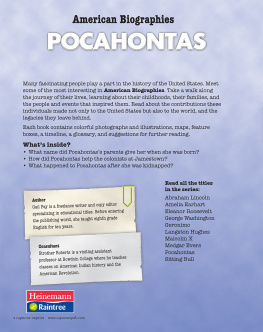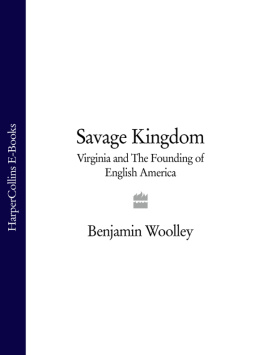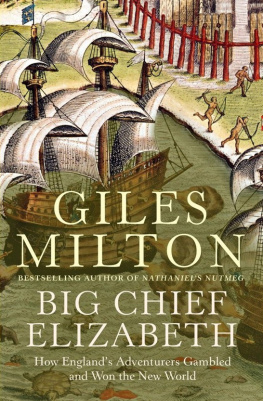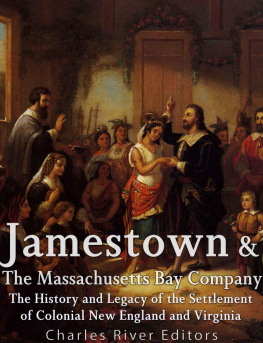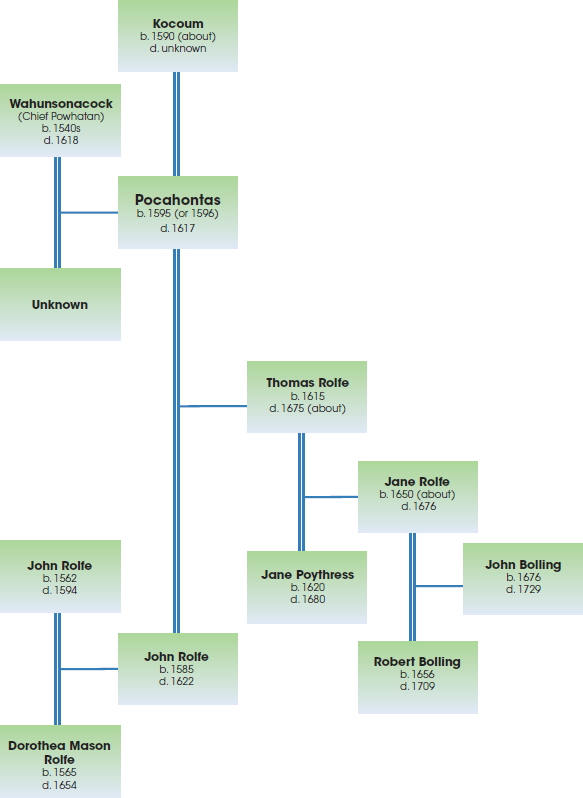Timeline
1300sAlgonquian-speaking American Indians from Canada move to the tidewater region of present-day Virginia.
1540sChief Powhatan is born as Wahunsonacock.
1595 or 1596Pocahontas is born as Matoaka.
November 1606King James I gives the Virginia Company of London permission to form a colony in the tidewater region of modern-day Virginia.
April 1607The ships Susan Constant, Godspeed, and Discovery enter Chesapeake Bay.
May 1607English settlers start building the Jamestown colony. Pocahontas starts visiting Jamestown shortly afterward.
December 1607John Smith is kidnapped by Opechancanough and taken to Werowocomoco. He later writes of being rescued by Pocahontas.
January 1608Fire destroys most of Jamestown.
October 1609John Smith returns to England.
Winter 16091610This period is known as the Starving Time.
1610Pocahontas marries Kocoum and moves to a Patawomeck village.
1610Settlers decide to leave Jamestown, but Sir Thomas De La Warr orders the ships back to shore, and the colony is rebuilt.
1611Sir Thomas Dale founds the Henrico settlement.
1612John Rolfe starts growing tobacco in Jamestown.
Spring 1613Captain Samuel Argall kidnaps Pocahontas.
Spring 1614Pocahontas is baptized and named Rebecca.
April 1614Pocahontas marries John Rolfe. The Peace of Pocahontas begins.
January 1615Pocahontass son, Thomas, is born.
Spring 1616Pocahontas and her family go with Sir Thomas Dale to England.
March 1617Pocahontas dies in Gravesend, England. John Rolfe returns to Jamestown.
1618Chief Powhatan dies. Opechancanough and his brother become rulers of the Powhatan Confederacy.
1622John Rolfe dies.
1622Opechancanough launches a surprise attack on English settlements, and the Peace of Pocahontas ends.
1644Opechancanough is kidnapped and later killed.
1646The English start forcing Powhatans onto reservations.
Find Out More
Books
Brimner, Larry Dane. Pocahontas: Bridging Two Worlds. Tarrytown, N.Y.: Marshall Cavendish, 2008.
Harkins, Susan Sales, and William H. Harkins. Whats So Great About Pocahontas? Hockessin, Del.: Mitchell Lane, 2008.
Jenner, Caryn. Pocahontas. New York: Dorling Kindersley, 2009.
Jones, Victoria Garrett. Pocahontas: A Life in Two Worlds. New York: Sterling, 2010.
Sita, Lisa. Pocahontas: The Powhatan Culture and the Jamestown Colony. New York: PowerPlus Books, 2005.
DVDs
Biography: PocahontasAmbassador of the New World. A&E Home Video, 2005.
Pocahontas Revealed. WGBH Boston, 2007.
Websites
Jamestown Settlement and Yorktown Victory Center
www.historyisfun.org/
This is the website of the Jamestown Settlement in Williamsburg, Virginia. It has information about the museums and the outdoor living history displays at the Jamestown Settlement. It also has links to short articles, videos, and podcasts about Pocahontas, Jamestown, the Powhatan Indians, and more.
The Real Pocahontas
http://pocahontas.morenus.org/
This website has information on Pocahontas, Chief Powhatan, John Smith, and more. It includes two charts comparing the real story of Pocahontas with the Disney movies Pocahontas and Pocahontas II. This website also has a family tree of Pocahontass descendants, as well as a list of books on Pocahontas and Jamestown.
Powhatan Indian Fact Sheet
www.bigorrin.org/powhatan_kids.htm
This website has information on the Powhatan Indians who lived in Virginia. Topics include Powhatan houses, clothing, religion, food, and more.
Powhatan Museum of Indigenous Arts and Culture
www.powhatanmuseum.com/
This website has links to information on Pocahontas, Chief Powhatan, Powhatans brother Opechancanough, the Powhatan Indians today, and more. It includes a map showing the area controlled by Powhatan. It also has a Childrens Corner link where you can learn which English words of today come from the Algonquian language.
Places to visit
Jamestown Settlement
2110 Jamestown Road Williamsburg, VA 23185 888-593-4682
www.historyisfun.org/jamestown-settlement.htm
Pamunkey Indian Tribe Museum
175 Lay Landing Road King William, VA 23086 804-843-4792
www.pamunkey.net/museum.html
Smithsonian National Museum of the American Indian
Fourth Street & Independence Avenue, SW Washington, DC 20560 202-633-1000
www.nmai.si.edu/
Pocahontas, the Playful One
Pocahontas has an important place in U.S. history. She brought food to the starving European settlers who were trying to start a settlement at Jamestown, in present-day Virginia. As a result, the colonists survived and Jamestown became the first permanent settlement in North America. Pocahontas was also a peacemaker. She helped keep peace between the English settlers and her people, the Powhatan Indians. She carried messages between her father, Chief Powhatan, and the colonists. Some people say that Pocahontas even rescued one of the colonists from death.
Here is the amazing part: Pocahontas was about 12 years old when these events took place! She was an energetic girl who loved to play with others. Pocahontas and her friends raced along the dirt paths and swam in the rivers. They played games in the open fields. Pocahontas also turned cartwheels with the boys in Jamestown. Today she might have been called a tomboy.
Did you know?
When Powhatan children were born, they were given special tribal names. The Powhatans believed these names had magical powers to protect them. To save those powers, only family members used a persons tribal name. Everyone else used a nickname. Pocahontass magical name was Matoaka, but most people called her Pocahontas.
This playful girl also knew when to calm down. She often stood quietly by her fathers side as he met with important people. Pocahontas had a special relationship with her father. Colonists later described her as the chiefs dearest daughter.
The name Pocahontas means mischievous or playful. Pocahontas may have been given this nickname because she was so active and curious.
Eyewitness accounts
Most of what people know about Pocahontas comes from the writings of John Smith. Smith and others founded the English colony at Jamestown. Smith also became friends with Pocahontas. He wrote five books about the Jamestown settlement.
William Strachey also wrote about Pocahontas. Strachey came to Jamestown in 1610. He wrote about everyday life in Jamestown. He also recorded stories from colonists who had lived in the settlement since it was founded. These stories often involved Pocahontas.
The books by Smith and Strachey are called primary source

